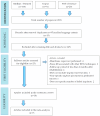Influence of Schneiderian Membrane Perforation on Implant Survival Rate: Systematic Review and Meta-Analysis
- PMID: 38999315
- PMCID: PMC11242322
- DOI: 10.3390/jcm13133751
Influence of Schneiderian Membrane Perforation on Implant Survival Rate: Systematic Review and Meta-Analysis
Abstract
Background: Maxillary sinus lift is a well-documented and accepted technique in the rehabilitation of the posterior maxilla. Schneiderian membrane perforation is the most common complication and may occur in between 7% and 56% of cases. Different materials and techniques have been described to achieve reparation of the perforation. The aim of this study was to establish whether the perforation of the Schneiderian membrane and its repair during maxillary sinus lift surgery results in a lower implant survival rate compared to those cases where the membrane has not been perforated. Materials and methods: A systematic review and meta-analysis of studies assessing the survival rate of implants placed in regenerated sinus using the lateral window approach, where the perforation of the Schneiderian membrane occur, was carried out. Statistical analysis was performed with Open Meta-Analyst, calculating the odds ratio of implants placed in perforated sinuses and non-perforated sinuses. Results: Ten articles were included in the qualitative analysis and seven articles in the quantitative analysis or meta-analysis. A total of 1224 maxillary sinus augmentation surgeries were performed without perforation of the Schneiderian membrane and 2725 implants were placed; 62 implants failed during the follow-up period with an overall survival rate of 97.7%. In 480 perforated sinuses, 1044 implants were placed, of which 30 failed; the overall survival rate was 97.1%. There were no significant differences between the implant survival rate of the implants in the two groups (OR = 0.78; CI = 0.49-2.23; p = 0.28 and I2 heterogeneity: 0%, p = 0.44). Conclusions: Schneiderian membrane perforation, as long as it is repaired, does not appear to negatively influence implant survival rate. Membrane perforation should not be considered a reason to abort the procedure or an absolute contraindication to implant placement.
Keywords: bone regeneration; dental implants; maxillary sinus membrane; sinus floor augmentation.
Conflict of interest statement
The authors declare no conflicts of interest.
Figures





References
-
- Arcas-Sanabre A.J., Gutierrez-Santamaria J., López-López J., Ayuso-Montero R., Velasco-Ortega E. Horizontal augmentation of the maxillary alveolar ridge to change the prosthetic profile: Clinical and radiological results of a retrospective study. J. Stomatol. Oral Maxillofac. Surg. 2020;121:25–29. doi: 10.1016/j.jormas.2019.08.001. - DOI - PubMed

